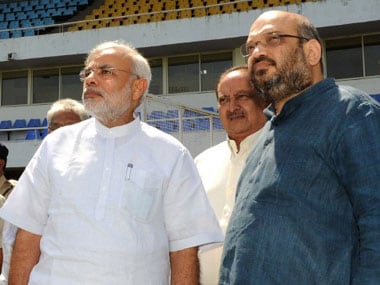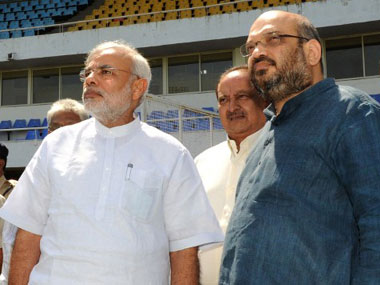In an insightful article published last week in The Hindustan Times, political columnist Swapan Dasgupta, who had vigorously endorsed Modi’s candidature for the post of PM, raised an important question relating to the NDA government’s incremental approach to reforms. This question stood somewhat in contrast to the BJP’s hyper aggressive political expansionism, especially in states where they are known to be traditionally weak. [caption id=“attachment_2029253” align=“alignleft” width=“380”] The aggressive policies of Amit Shah (right) may harm PM Narendra Modi’s development agenda. AFP[/caption] It is now open secret that BJP President Amit Shah’s unusually aggressive political play has angered regional leaders like Mamata Banerjee, Naveen Patnaik and even Sukhbir Badal, who is part of NDA. It is evident that the BJP’s hostile approach is not helping Modi build a cooperative framework with regional leaders and opposition CMs to push for big reforms. And the Sangh Parivar elements, in their own way, are distracting Modi’s attention from the developmental agenda. All this is giving enough reason to the opposition, which is bent upon blocking the legislative reforms in Rajya Sabha. Several questions arise from this state of play. “How do we reconcile the fact that while the government is still fixing the leaks in the system, the BJP under Amit Shah has moved into top gear and is audaciously preparing for political expansion in hitherto uncharted territories? Is there a rationale behind the modesty of change in government and the aggressive designs in politics?” Swapan Dasgupta asks. These questions raised by the author possibly tell a story which one can only speculate about at present. The key question Swapan asks but does not answer is whether there is a method behind the modesty of change in government and the aggressive designs in politics which Amit Shah is driving. Could it be possible that Modi and Amit Shah are taking a calculated political risk of letting the opposition/regional leaders exhaust themselves stonewalling reforms in Rajya Sabha for another year and a half? The BJP may have settled for incremental change till mid-2016 when its strength in Rajya Sabha would likely cross the half way mark of 126 members. At present, BJP has only 50 members in the Upper House. Indeed, if this is the strategy, then Amit Shah’s deliberate needling of regional leaders like Mamata Banerjee, Naveen Patnaik and the Badals has internal coherence. Recently, Naveen Patnaik came out in the open to suggest the BJP was using its power at the Centre to destabilise the BJD government in Odisha. Mamata has made similar accusation of misuse of CBI by the NDA to intimidate her government. Similarly, Punjab CM’s brother in law and Revenue minister, Bikram Singh Majithia, is also being pursued by the Enforcement Directorate for alleged links with the widespread drug mafia in Punjab. Ironically, the BJP and the Badals were on the best of terms till the other day. So the BJP’s aggressive political designs will certainly not help Modi create the kind of “cooperative federalism” framework that he is hoping to create. Swapan also hints that Amit Shah’s strategy could carry some risks. He argues that the opposition, left and liberal intellectuals and sections of the media could get together to paint Modi as ineffectual if the developmental agenda does not visibly take off until mid-2016 when the BJP is expected to get a majority in the Upper House. The point is that if the political momentum to push for development is lost in the first two years, it will become difficult to revive it after mid-2016. For one key constituency which endorsed Modi is the global investing community. Whether you like it or not, global finance capital has great expectations of Modi and may not have the patience to wait until 2016 to get some good returns on their investments. If this community turns away and does not bring in the investments promised to Modi during his high profile visits to the developed economies last year, some economic indicators like the exchange rate and balance of payments could get seriously impacted. A negative sentiment turn is difficult to salvage as the UPA learnt to its detriment in 2012. Modi may have to lower his party’s hostility to regional leaders and put his hot headed brethren from the Sangh Parivar back in the bottle in 2015.
The aggressive policies of Amit Shah (right) may harm PM Narendra Modi’s development agenda. AFP[/caption] It is now open secret that BJP President Amit Shah’s unusually aggressive political play has angered regional leaders like Mamata Banerjee, Naveen Patnaik and even Sukhbir Badal, who is part of NDA. It is evident that the BJP’s hostile approach is not helping Modi build a cooperative framework with regional leaders and opposition CMs to push for big reforms. And the Sangh Parivar elements, in their own way, are distracting Modi’s attention from the developmental agenda. All this is giving enough reason to the opposition, which is bent upon blocking the legislative reforms in Rajya Sabha. Several questions arise from this state of play. “How do we reconcile the fact that while the government is still fixing the leaks in the system, the BJP under Amit Shah has moved into top gear and is audaciously preparing for political expansion in hitherto uncharted territories? Is there a rationale behind the modesty of change in government and the aggressive designs in politics?” Swapan Dasgupta asks. These questions raised by the author possibly tell a story which one can only speculate about at present. The key question Swapan asks but does not answer is whether there is a method behind the modesty of change in government and the aggressive designs in politics which Amit Shah is driving. Could it be possible that Modi and Amit Shah are taking a calculated political risk of letting the opposition/regional leaders exhaust themselves stonewalling reforms in Rajya Sabha for another year and a half? The BJP may have settled for incremental change till mid-2016 when its strength in Rajya Sabha would likely cross the half way mark of 126 members. At present, BJP has only 50 members in the Upper House. Indeed, if this is the strategy, then Amit Shah’s deliberate needling of regional leaders like Mamata Banerjee, Naveen Patnaik and the Badals has internal coherence. Recently, Naveen Patnaik came out in the open to suggest the BJP was using its power at the Centre to destabilise the BJD government in Odisha. Mamata has made similar accusation of misuse of CBI by the NDA to intimidate her government. Similarly, Punjab CM’s brother in law and Revenue minister, Bikram Singh Majithia, is also being pursued by the Enforcement Directorate for alleged links with the widespread drug mafia in Punjab. Ironically, the BJP and the Badals were on the best of terms till the other day. So the BJP’s aggressive political designs will certainly not help Modi create the kind of “cooperative federalism” framework that he is hoping to create. Swapan also hints that Amit Shah’s strategy could carry some risks. He argues that the opposition, left and liberal intellectuals and sections of the media could get together to paint Modi as ineffectual if the developmental agenda does not visibly take off until mid-2016 when the BJP is expected to get a majority in the Upper House. The point is that if the political momentum to push for development is lost in the first two years, it will become difficult to revive it after mid-2016. For one key constituency which endorsed Modi is the global investing community. Whether you like it or not, global finance capital has great expectations of Modi and may not have the patience to wait until 2016 to get some good returns on their investments. If this community turns away and does not bring in the investments promised to Modi during his high profile visits to the developed economies last year, some economic indicators like the exchange rate and balance of payments could get seriously impacted. A negative sentiment turn is difficult to salvage as the UPA learnt to its detriment in 2012. Modi may have to lower his party’s hostility to regional leaders and put his hot headed brethren from the Sangh Parivar back in the bottle in 2015.
Not just the RSS; aggressive Amit Shah may scuttle Modi's development agenda
MK Venu
• January 4, 2015, 18:54:29 IST
It is now open secret that BJP President Amit Shah’s unusually aggressive political play has angered regional leaders. It may further harm PM Modi’s agenda.
Advertisement
)
End of Article